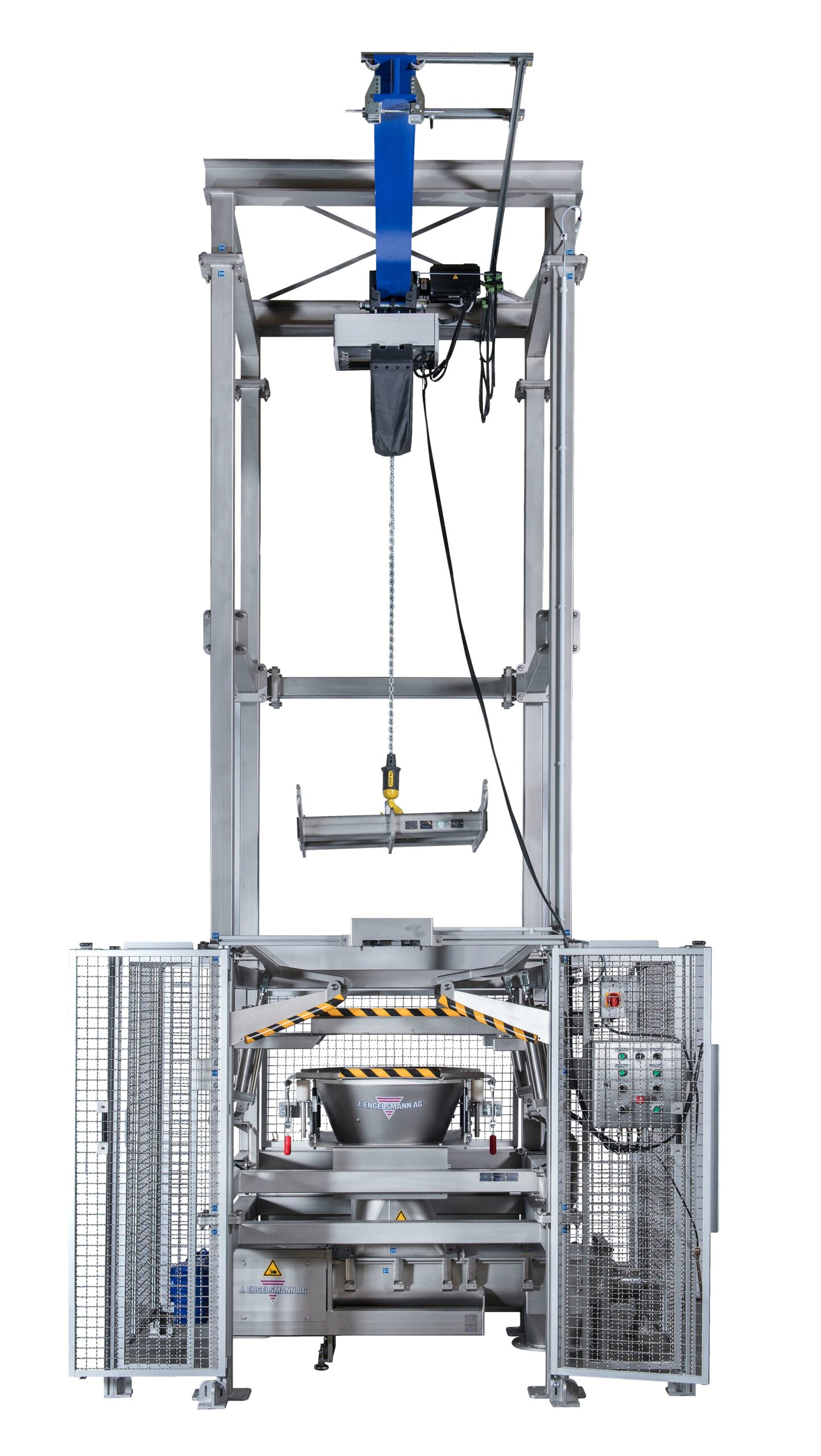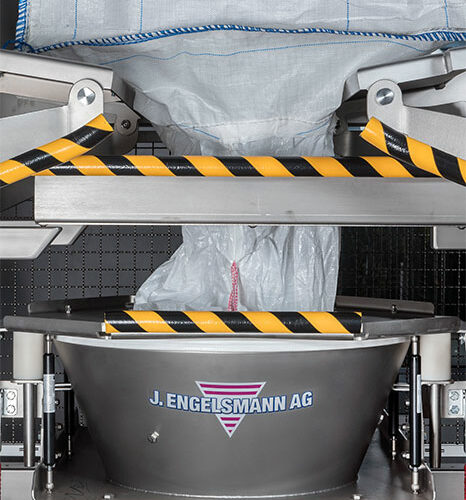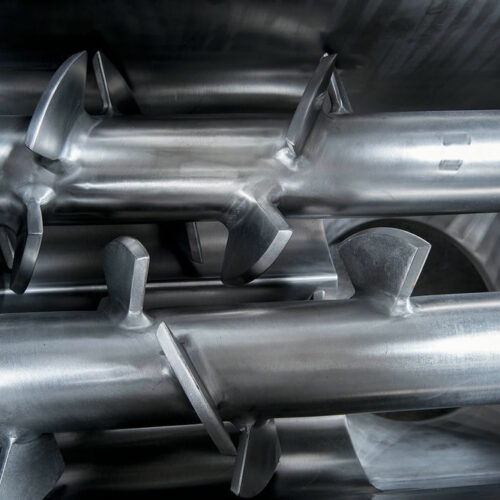A well-known company produces numerous branded products in the cosmetics and body care sector. They were looking for a new emptying station to empty greasy soap noodles from big bags.
More throughput and more productivity!
According to this motto, the customer planned to replace an old big bag emptying rack by a modern big bag emptying system. Soap noodles delivered in big bags have to be emptied as residue-free as possible with the new system and conveyed into a mixer on site.
The big bag system used so far no longer allows any increase in capacity. In addition, only a screw was used to empty the soap noodles out of the big bag – without any additional discharging aid. The result: the soap noodles, which clump together due to their fat content, frequently clogged the screw and the desired dosing accuracy could not be achieved during the big bag emptying process.
Soap noodles easily form a “soap dust” and also tend to bridge. Product characteristics that had to be taken into consideration during the design and production process of the new big bag emptying system.
Trials in the technical test centre for a product- and demand-oriented solution
In another plant, a similarly product such as the fat-containing soap noodles has been emptied with a big bag station from Engelsmann for several years.
As with the conception of the first big bag system, tests in the Engelsmann technical centre were first on the agenda. In order to precisely match the emptying station to the product and process requirements, a test setup was installed together with the customer’s technical project team. With the original product, different test series could be run until the design of the individual components of the big bag emptying station was determined.
The tests in the technical pilot centre not only provided important insights into product-specific flow behaviour, required discharge aids, the dust-tightness of the big bag system or similar. Right at the beginning of the project, the customer was assured that the system would meet the requirements and work smoothly in real operation.
Emptying 8 big bags per hour
For high-performance emptying of the greasy product, the Big Bag system developed by Engelsmann is designed for a throughput of 12 tonnes per hour.
Design and operation of the Big Bag emptying station
The big bag filled with soap noodles is transported on a pallet to the emptying station. The station is equipped with a crane track, including a flat-built electric chain hoist and loading gear.
The loading harness is lowered to secure the four loops of the big bag in the holding hooks of the harness. Then the 1.5t Big Bags with soap noodles are conveyed upwards and lowered into the emptying position in the frame rack.
In the next step, the big bag is connected to the emptying funnel of the station. To do this, the emptying spout of the still closed big bag is inserted into the emptying hopper from above. The unit’s pressure plate is lowered manually and the big bag is now securely connected to the station to form a closed system. The soap noodles can be emptied safely, dust-free and efficiently.
Is it possible to empty only a part of the big bag and then close it again?
In order to implement the partial emptying option requested by the customer, the big bag can be closed again at the push of a button. A closing device integrated in the emptying hopper interrupts the product flow and the big bag can be safely tied and transported out of the station again.
Regardless of whether complete emptying or partial emptying – so that no soap noodles get stuck in the folds of the big bag, a spring tensioner keeps the side walls of the big bag taut at all times during the emptying process.

Soap noodles have unfavourable flow properties. What happens to the clumps in the big bag?
For a smooth product flow, an fulling aid has been integrated as an emptying aid. The two pneumatically operated cheeks break up clumped soap noodles before they are emptied from the big bag. At the same time, they serve as fall protection. Speaking of safety and accident prevention: In order to ensure safe handling for the operating personnel, a protective enclosure has been installed around the Big Bag emptying station in accordance with the accident prevention regulations (UVV). The station itself is equipped with an emergency stop safety switch.
Discharge aid with dosing screw
Conveying the soap noodles after emptying from the big bag
Dosing during emptying is done with a double screw and a fully automatic weighing system. The “soap dust” produced when emptying the soap noodles is removed by an on-site dust removal system.
The double-shaft screw conveyor pulls the soap noodles in after they have been emptied from the big bag and further breaks up the clumps that have already been pre-crushed by the fulling device. Both the arrangement of the paddles on the two shafts and their shape are precisely adapted to the product or flow properties of the soap noodles. In this way, the best possible grinding of the product is achieved, which can be easily conveyed by the screw. It pushes the product into the down pipe connected without causing any blockages. The soap noodles then reach the on-site mixing tank via a downpipe, shut-off flap and vapour barrier. To prevent the greasy soap noodles from sticking, the surfaces of the interior as well as parts that come into contact with the product are ground and polished.
Dosing takes place in combination with an on-site vessel weighting system. For this purpose, both components – screw conveyor and weighing system – are coupled via the process control system (PCS). In this way, an automated coarse dosing can take place. And fine dosing can also be mapped. Decoupling from the scales is done by a flexible compensator.


Throughput increased by 50%
With the combination of a modern big bag emptying station, screw conveyor and weighing system, the soap noodles can be emptied more efficiently and dosed more precisely than before. The emptying process runs smoothly and the downstream mixing process is fed with soap noodles in the appropriate processing quality. With an emptying solution from Engelsmann that is consistently matched to the product, it was thus possible to minimise downtimes and double the throughput per hour.

